The International Monetary Fund has projected India’s GDP growth at 9.5% in 2021 and 8.5% in 2022, making it the fastest-growing economy in the world. Deepak Parekh of HDFC, doyen of the private sector, says he is more optimistic than he has been for 50 years.
IMF believes fast growth in 2021 is not a one-off recovery from Covid, and India is bouncing back to miracle growth status after having gone downhill from 8.3% in 2016-17 to 4.2% in 2019-20 before Covid struck. Such optimism has been derided by pessimists like former Chief Economic Advisor Shankar Acharya, who fears long-term growth may be no more than 5%.I am more optimistic but see many challenges that could derail growth.
GDP growth has been strong in 2021 despite the Delta wave in April-June. The Centre’s tax revenue in April-August was an extraordinary 41% of the annual estimate against only 18.3% last year (because of Covid) and 30.7% the preceding year. Compared with the pre-Covid period two years ago, tax revenue has grown at a compound rate of 16% per year, corporate tax at 23%, excise duty at 34%, and GST at 6%.
Exports stagnated at around $300 billion after 2014 but have boomed this year and may be $360-400 billion. Credit Suisse estimates that two-year compound export growth (starting before Covid) is 17% per year. Imports have boomed too but the current account deficit should be manageable at 2-2.5% of GDP, and that is more than covered by foreign direct investment and other dollar inflows. Over 50% of FDI is now in digital enterprises against 20% a few years ago, reflecting the creation of over 100 “unicorns” (unlisted start-ups worth a billion dollars).
However, the economy faces major challenges in 2022. The most obvious is the Omicron variant of Covid. Experts say more variants may follow. We stand warned of possible tragedies.
The second major challenge is inflation. The Consumer Price Index puts inflation at 4.9% in November, within RBI target band of 2-6%. But the Wholesale Price Index has been in double digits for eight months, culminating in a whopping 14% in November. High inflation squeezes purchasing power, especially of the poorer half of the population already hit by Covid. Consumption is a weak spot in the economy and inflation could weaken it further.
The Finance Commission has suggested new rates for GST that could raise prices another 150 basis points. The price of oil has recently fallen from $80/barrel to $72/barrel, but persistent under-investment in this sector for years has led some experts to predict $100/barrel in 2022.
The third risk is higher interest rates. Central banks everywhere are planning tighter monetary policy to curb inflation. RBI has so far kept monetary policy fairly easy but will have to tighten it in 2022. However, the broad picture is that the world has a savings glut that has made real interest rates negative, so any rise in 2022 should be bearable.
In 2013 Indian markets collapsed because of a “taper tantrum” when the US Fed threatened to raise interest rates and trillions of dollars fled from emerging markets. The Fed now proposes to raise interest rates three times in 2022, but Indian markets look set to shrug that off this time. The current account deficit is under control and forex reserves have soared to $640 billion.
The biggest challenges run deeper. Narendra Modi came to power in 2014 promising jobs for all, but employment has been the biggest failure of his seven years. The unemployment rate has risen from 2% to around 7.5% in most of 2021, according to the Centre for Monitoring Indian Economy.
China’s demographic dividend was supposed to be ending even as India’s rose, but India’s labour force participation rate has plummeted alarmingly. Barely 40% of Indians seek work, and just 38.2% are employed according to the Periodic Labour Force Survey. In China 66.8% are seeking work and 63.5% are employed, dwarfing India. Female labour participation in agriculture has collapsed and has always been very low in urban areas. Social mores and urban crime discourage female workers. We see no light at the end of this tunnel.
Education remains a black hole. Pratham’s surveys suggest very little improvement from abysmally low levels in reading and maths for a decade. India came second last in its only international school competition. No light at the end of this tunnel either.
Finally, political risks to economic reform have soared with the success of farmers’ agitation. Modi is now going slow on labour reforms: four labour laws already enacted have not been formally notified. Privatisation of state-owned electricity distribution companies has been postponed after strike threats by electricity employees. Progress in selling other assets is glacial.
Many liberals and libertarians would love to see BJP lose outright in the coming Uttar Pradesh election, unlikely though that is. But BJP’s loss in UP would deal a body blow to further economic reforms. BJP will shift its focus to communalism, sabre-rattling, and populist giveaways. Sometimes win-win outcomes are impossible.
This article was originally published in The Times of India on December 29, 2021.


